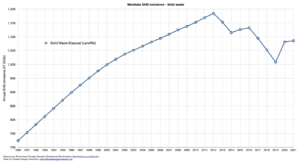Although waste accounted for only 6% of Manitoba’s greenhouse gas (GHG) emissions in 2021, it has increased significantly since 1990. The 2021 level was 50% higher than in 1990. (1)The greenhouse gases (GHG) in the waste category are the on-site emissions from disposal of solid waste, as well as waste or wastewater treatment.
Sources of these emissions include the following:
- landfilling of solid waste
- flaring of landfill gas
- treatment of liquid waste
- waste incineration. (1)
A major source of the GHG from landfill comes from the decomposition of organic waste. (1) Organic waste in landfills produces methane. This is because the waste is covered in the landfill. Once covered, the organic material decomposes anaerobically (i.e. without oxygen) and produces methane. Methane has 25 times the Global Warming Potential (GWP) of carbon dioxide (CO2).
If you compost, the organic waste produces CO2.
However, the Province of Manitoba and the City of Winnipeg put a capping system over the Brady Landfill in 2012. This system has been trapping the gases that would have escaped due to the decomposition of organic matter in the dump.
The methane is being “flared” or burned off. Flaring changes the methane to CO2. This reduces the global warming by a factor of 25.
For a printable PDF file with the data, click here: Manitoba_GHG_trend_chart_1990-2021_waste.pdf – 84 KB





